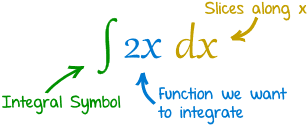Riemann Sums
Riemann Sum: a method for approximating area by adding the areas of rectangles.
RRAM- RIGHT Rectangle Approximation Method, using the right endpoint of the graph as the base, and the interval as the height.
LRAM- LEFT Rectangle Approximation Method, using the left endpoint of the graph as the base, and the interval as the height.
MRAM- MIDPOINT Rectangle Approximation Method, using the midpoint of the graph as the base, and the interval as the height.
TO CALCULATE: interval*(f(x1)+f(x2)+f(x...))
ie. Approximate the area of a region bounded by f(x)=5-x^2 and the x-axis between [0,2].
RRAM- .5(f(.5)+f(1)+f(1.5)+f(2))
LRAM- .5(f(0)+f(.5)+f(1)+f(1.5))
MRAM-.5(f(.25)+f(.75)+f(1.25)+f(1.75))
The Trapezoid Rule
Another method of Approximation is the Trapezoid Rule, using trapezoids to find the area under a curve.
A(trapezoid)= .5h(b1+b2)
Then you just add the areas together.
A= interval(f(x0) + 2f(x1) + 2(fx2)... + f(xlast))
This is not a Riemann Sum
Integral and Integral Notation
Integral/Integral Notation- The integral is the signed area between the graph of a curve and the x-axis.
How to write an integral goes as pictured above. When typing the integral into a calculator, you must put the domain in which you are finding the integral. If the domain is [a,b], the b goes at the top of the integral symbol, and the a goes on the bottom as prompted by the calculator. It should look like this.
To enter an integral into your calculator, press the button that is located next to the open book button. Then chose the prompt highlighted below, and type the equation as shown above.





